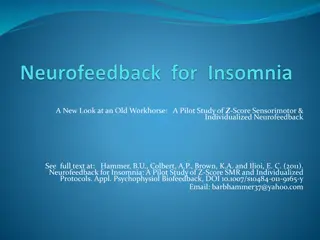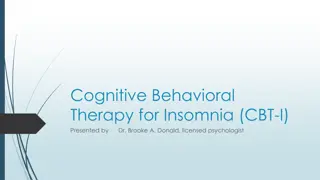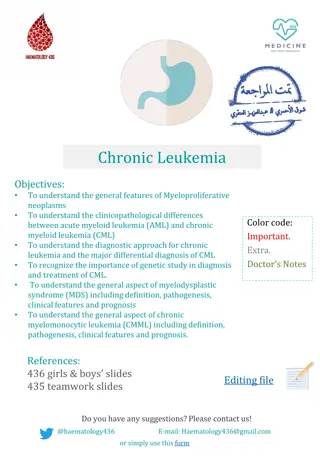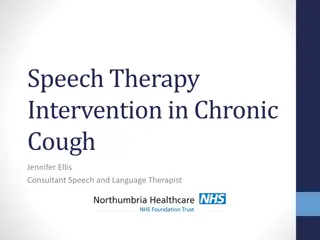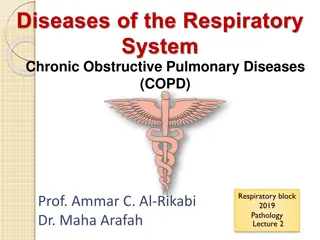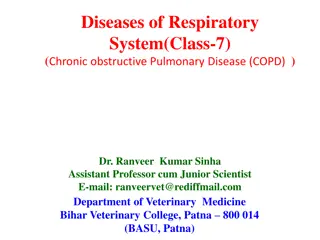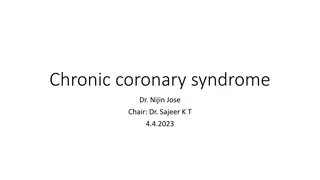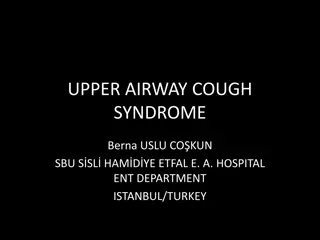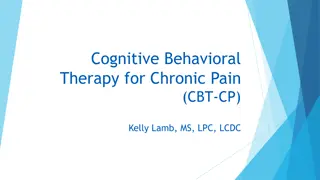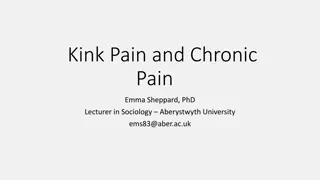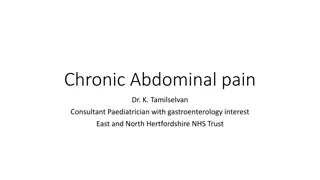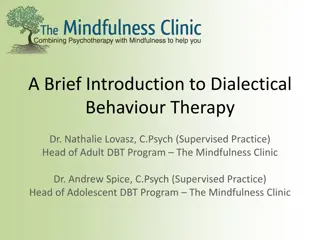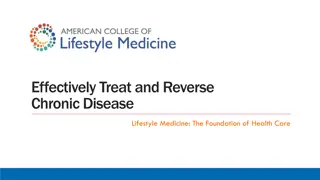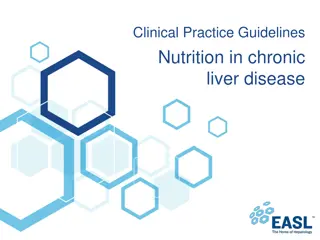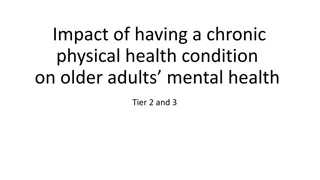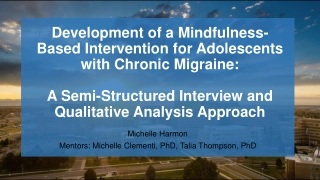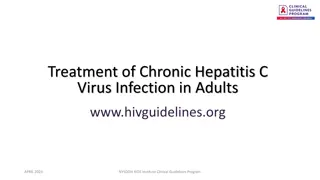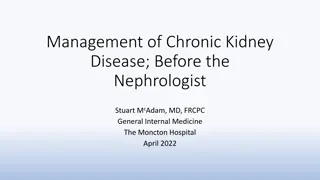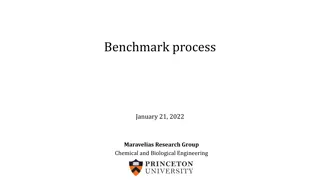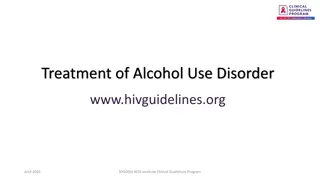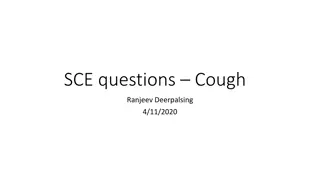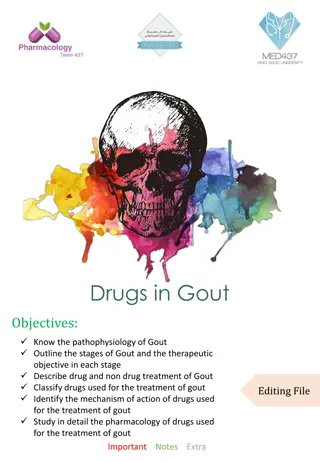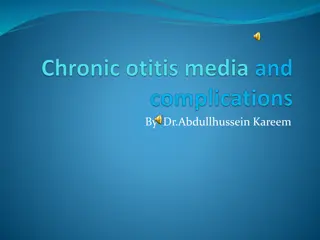Understanding Chronic Insomnia: Case Presentation and Treatment Options
Emily Medina, a Pharm.D. Candidate, presents a case of a 31-year-old female with chronic primary insomnia despite previous treatment trials. The case highlights the challenges and consequences of chronic insomnia, discussing the definition, prevalence, and risks associated with this disorder. Alternative treatment options are explored, focusing on non-benzodiazepine and non-z-hypnotic approaches such as Gabapentin and Mirtazapine.
Download Presentation

Please find below an Image/Link to download the presentation.
The content on the website is provided AS IS for your information and personal use only. It may not be sold, licensed, or shared on other websites without obtaining consent from the author. Download presentation by click this link. If you encounter any issues during the download, it is possible that the publisher has removed the file from their server.
E N D
Presentation Transcript
Insomnia: A Case Presentation Emily Medina Pharm.D Candidate 2023
AD is a 31-year-old female with a PMH of migraines (with aura), adult acne vulgaris, and subclinical hyperthyroidism. She presented to her PCP with a chief complaint of primary chronic insomnia. She reports getting about 4 hours of sleep per night and she is also having trouble falling asleep, even with pharmacologic treatment. When she does sleep, she reports waking up several times throughout the night. She also reports fatigue throughout the day and anxiety over her lack of sleep. Her current medication list at the time of the visit was as follows: Tretinoin Cream 0.05% - AAA daily Clindamycin-Benzoyl Peroxide 1-5% gel - AAA daily Spironolactone 100mg 1 tablet daily Trazodone 100mg 1 tablet QHS prn sleep Doxepin 3mg 1 tablet 30 minutes before bedtime 2
Question from provider: AD has trialed Melatonin, Doxepin, Trazodone, Hydroxyzine Pamoate, Doxylamine for primary insomnia and none of them worked for her. Are there any good alternatives for treatment of primary insomnia without using benzodiazepines or z-hypnotics? Could Gabapentin or Mirtazapine be a good option for her? 3
Insomnia Insomnia disorder is defined as complaint of trouble initiating or maintaining sleep which is associated with daytime consequences and is not attributable to environmental circumstances or inadequate opportunity to sleep1. The disorder is characterized as chronic once it has persisted for >3 months. When the disorder meets the symptom criteria but has not persisted for at least 3 months, it is considered short-term insomnia 4
Insomnia Occasional, short-term insomnia affects 30-50% of the population, while the prevalence of long-term insomnia is estimated to be at least 5-10% in industrialized nations.1 The prevalence is significantly increased in medically and psychiatrically ill populations, and in older age groups.1 Chronic insomnia is associated with many adverse effects on health and function. 5
Chronic insomnia increases the risk of: Psychiatric Disorders2,3 Work Hypertension7,8 Absenteeism4 Occupational and Motor Vehicle Accidents5,6 Worse outcomes in chronic pain Relapse of depression or alcoholism 6
So, you have insomnia, now what? Image Source 7
Types of insomnia Difficulty falling asleep Sleep Onset Difficulty staying asleep Sleep Maintenance Difficulty falling asleep and staying asleep Mixed 8
What type of insomnia does AD have? Patient reports waking up multiple times per night even when she is able to sleep Patient reports difficulty falling asleep Patient reports only getting ~ 4 hours of sleep a night Mixed Insomnia 10
Could ADs chronic mixed insomnia be caused by something else? 11
What can influence sleep? Sleep Hygiene Stress Medications Exercise Caffeine Comorbidities Alcohol 12
In ADs case she is not on any medications that are known to cause or contribute to Insomnia. However 13
Her toxicology screen did come back positive for both caffeine and diphenhydramine She is in nursing school, working a full-time job, and is caring for her young child, and reports a fair amount of stress, and lack of opportunity for sleep some nights She reported a fair amount of anxiety, and has been visibly anxious in clinic multiple times, so there is a possibility of an underlying anxiety disorder 14
Cognitive Behavioral Therapy for Insomnia (CBT-I) Considered first-line therapy for chronic insomnia in most patients (if available and affordable) The cognitive components address: Anxious and catastrophic thoughts associated with sleeplessness Inappropriate expectations about hours of sleep Misattributions regarding the effects of sleeplessness Relaxation through progressive muscle relaxation, mindfulness, and meditation The behavioral components involve: Establishment of a stable bedtime and awakening time Reduction of time in bed using bed only for sleep, if anxious and unable to sleep, get out of bed. Trying to sleep only when sleepy Maximizing sleep hygiene, avoiding substances that interfere with sleep 15
Cognitive Behavioral Therapy for Insomnia (CBT-I) Study Description Results Morin et al. (2009) Randomized Controlled Trial Prospective, randomized controlled trial involving 2-stage therapy for 160 adults with persistent insomnia. Participants received either CBT alone or CBT plus 10mg/day of Zolpidem for an initial 6-week therapy, followed by extended 6-month therapy of either CBT alone or CBT+ Zolpidem CBT used alone or in combination with zolpidem produced significant improvements in sleep latency, time awake after sleep onset, and sleep efficiency during initial therapy (all P<.001); a larger increase of sleep time was obtained with the combined approach (P = .04). The best long- term outcome was obtained with patients treated with combined therapy initially, followed by CBT alone, as evidenced by higher remission rates at the 6-month follow-up compared with patients who continued to take zolpidem during extended therapy (68% [20/30] vs 42% [12/29]; P = .04). 16
Would AD benefit from CBT-I? It is very likely she would benefit from CBT-I It would help address her anxiety around sleep and improve her sleep behaviors that are contributing to inadequate sleep However, she does have a very busy, and erratic schedule that would make scheduling time for therapy difficult, so patient would have to be open to and dedicate time for CBT-I 17
So, lets talk about Melatonin We suggest that clinicians not use melatonin as a treatment for sleep onset of sleep maintenance insomnia (versus no treatment) in adults (WEAK)1 18
Melatonin Only 3 studies on Melatonin included adequate data for the guideline s meta- analysis Study Description Results Lemoine et al (2007) Randomiz ed placebo- controlled study center randomized placebo-controlled study in 170 primary insomnia outpatients aged 55 years treatment group for new symptoms experienced during the run-out period compared with the double-blind period. There were no clinically significant changes or remarkable differences between the treatment groups in vital signs or physical examination results following 3 weeks of double-blind study treatment. The effects of 3- weeks prolonged- release melatonin 2mg versus placebo treatment were assessed in a multi- Improvements in quality of sleep (QOS) the night before andmorning alertness (BFW) were assessed using the Leeds Sleep Evaluation Questionnaire and changes in sleep quality (QON) reported on five categorical unit scales. PR-melatonin significantly improved QOS ( 22.5 versus 16.5mm, P=0.047), QON (0.89 vs. 0.46 units; P=0.003) and BFW ( 15.7 vs. 6.8 mm; P=0.002) compared with placebo. Results from the Tyrer Questionnaire, which assesses withdrawal symptoms, showed no apparent relationship to either 19
Melatonin Study Luthringer et al. (2009) Randomized, placebo- controlled study Description This study investigated the effects of prolonged-release melatonin 2 mg on sleep and subsequent daytime psychomotor performance in patients aged 55 years with primary insomnia. Patients (N = 40) were treated nightly single-blind with placebo (2 weeks), randomized double-blind to PRM or placebo (3 weeks) followed by withdrawal period (3 weeks). Sleep was assessed by polysomnography, all-night sleep electroencephalography spectral analysis and questionnaires. Results By the end of the double-blind treatment, the PRM group had significantly shorter sleep onset latency (9 min; P = 0.02) compared with the placebo group. Half of the patients reported substantial improvement in sleep quality at home with PRM compared with 15% with placebo (P = 0.018). No rebound effects were observed during withdrawal. There were 11 adverse events reported, and none were believed to be treatment-related 20
Melatonin Study Wade et al. (2007) Randomized, double blind, placebo- controlled trial Description 354 males and females aged 55 80 years were admitted to the study, 177 to active medication and 177 to placebo. The study was conducted by primary care physicians in the West of Scotland and consisted of a 2 week, single blind, placebo run-in period followed by a 3 week double blind treatment period with PR-melatonin or placebo, one tablet per day at 2 hours before bedtime Results Significant differences in favor of PR- melatonin vs. placebo treatment were found in concomitant and clinically relevant improvements in quality of sleep and morning alertness, demonstrated by responder analysis (26% vs. 15%; p=0.014) as well as on each of these parameters separately. A significant and clinically relevant shortening of sleep latency to the same extent as most frequently used sleep medications was also found ( 24.3 vs. 12.9 minutes; p=0.028). Quality of life also improved significantly (p=0.034) 21
Melatonin Overall, these studies relied heavily on subjective methods to determine efficacy (i.e. patient questionnaires) Because there is not much objective data, it is difficult to prove the efficacy of Melatonin. Even with subjective data, it looks like Melatonin at best could improve sleep latency anywhere from 9-12 minutes However, these studies did show that Melatonin is very safe, no treatment related adverse events were identified and no withdrawal effects were noted Because Melatonin is largely safe, even without proven efficacy, it can be worth trying in most patients, especially in older patients where using heavily sedating drugs are a concern. 22
We tried Melatonin, what next? Type of insomnia can help guide which treatment to choose 23
Recommended for Sleep Onset Insomnia Zaleplon Ramelteon Triazolam Temazepam Eszopiclone Zolpidem 24
Recommended for Sleep Maintenance Insomnia Doxepin Eszopiclone Temazepam Suvorexant Zolpidem 25
Not Recommended for Treating Insomnia Tiagabine Diphenhydramine L-Tryptophan Trazodone Valerian Melatonin 26
New insomnia medications DORAs DORA Dual orexin receptor antagonists They treat insomnia by blocking orexin signals in the brain that are believed to play a role in wakefulness These medications have antagonist activity at both orexin receptors (OX1R and OX2R), thereby facilitating sleep by decreasing the wake drive 3 are currently on the market, Suvorexant (Belsomra), Lemborexant (Dayvigo) and the newest medication to the market, Daridorexant (Quviviq) 27
DORAs Things to consider No long-term safety data is available yet They are all schedule IV-controlled medications (very-low abuse potential, no evidence of physical dependence) A recent meal can delay onset of action, and beware of CYP3A4 interactions All DORAs should be avoided in patients with severe hepatic impairment Most common adverse effect is somnolence, with some patient s experiencing dose-dependent impairment in driving the next morning They do not appear to cause respiratory depression; however, they have not been studied in patients with severe lung disease or sleep apnea Cost can be a limiting factor for patients 28
DORAs Suvorexant (Belsomra) Lemborexant (Dayvigo) Daridorexant (Quviviq) Starting dose: 10mg within 30 minutes of going to bed and having at least 7 hours before planned awakening time Starting dose: 5mg immediately before bed, with at least 7 hours available before planned awakening time Starting dose: 25mg or 50mg within 30 minutes of going to bed, with at least 7 hours available before planned awakening time Max dose: 20mg Max dose: 10mg Max dose: 50mg Half-life is ~12 hours Half-life is ~17-19 hours Half-life is ~8 hours Intended for sleep-maintenance insomnia, however some data at the 20mg dose have shown improvement in sleep latency, showing that it might be useful in sleep-onset insomnia at higher doses Has been shown to improve outcomes for sleep onset and sleep maintenance insomnia. Effects on sleep appear to be maintained with long-term use, with no clear evidence of withdrawal or rebound in the two weeks following drug discontinuation. Based on safety and efficacy data, 50mg is an appropriate initial dose that appears to be equally safe and somewhat more effective than 25mg Place in therapy: Significantly shorter half-life helps decrease next somnolence compared to other DORAs 29
Back to the question, would Mirtazapine or Gabapentin be good options for AD? There is limited efficacy data for treatment of insomnia with Mirtazapine However, it is used commonly in practice, and some experts find it useful in certain patients. Most of the data that supports Mirtazapine use in insomnia is in patients with a comorbid diagnosis of major depression Because our patient does not have comorbid depression, and has struggled with weight gain recently, I would not recommend Mirtazapine 30
Back to the question, would Mirtazapine or Gabapentin be good options for AD? There is limited efficacy data for treatment of insomnia with Gabapentin as well Gabapentin can be useful as a treatment of insomnia with certain patient populations including those with insomnia as well as comorbid chronic pain, restless leg syndrome, or those with alcohol use disorder As the patient does not have any chronic pain, alcohol use disorder, or restless leg syndrome, I would not recommend gabapentin either, as the potential for harm seems higher than the potential benefit. 31
So, what should we do for AD? Since the patient has failed many options, I do think a DORA could potentially be helpful for AD However, during patient interview, it was unclear if she would be able to dedicate at least 7 hours a night to sleep. If the patient could commit to 7 hours of sleep a night and a DORA was an option, I would choose Quviviq due to its shorter half-life leading to decreased next-day sleepiness If the patient is unable to make that work with her schedule, I would recommend a combination of CBT-I with a short 6-week maximum course of either Zolpidem IR or Zaleplon I would also consider screening the patient for an underlying anxiety disorder 32
What did the provider end up doing for AD? There was not much documentation in the chart, but the PCP did prescribe a 2-week course of Zolpidem IR 5mg with a follow-up scheduled 2 months later While I do not disagree with the medication choice, I do think the patient should have been referred to CBT-I, as that is proven to improve chance of treatment success Even without CBT-I, I would continue to work on sleep hygiene with the patient, as it appears that improving her sleep hygiene would influence her insomnia I would also still screen her for an underlying anxiety disorder at a follow-up appointment 33
Questions? 34
Bibliography 1. Sateia, Michael J., et al. Clinical Practice Guideline for the Pharmacologic Treatment of Chronic Insomnia in Adults: An American Academy of Sleep Medicine Clinical Practice Guideline. Journal of Clinical Sleep Medicine, vol. 13, no. 02, 2017, pp. 307 349. Breslau, N., Roth, T., Rosenthal, L., & Andreski, P. (1996). Sleep disturbance and psychiatric disorders: a longitudinal epidemiological study of young adults. Biological psychiatry, 39(6), 411-418. Baglioni, Chiara, et al. "Insomnia as a predictor of depression: a meta-analytic evaluation of longitudinal epidemiological studies." Journal of affective disorders 135.1-3 (2011): 10-19. Leigh, J. Paul. "Employee and job attributes as predictors of absenteeism in a national sample of workers: the importance of health and dangerous working conditions." Social Science & Medicine 33.2 (1991): 127-137. H gg, Shadi Amid, Kjell Tor n, and Eva Lindberg. "Role of sleep disturbances in occupational accidents among women." Scandinavian Journal of Work, Environment & Health (2015): 368-376. Laugsand, Lars Erik, et al. "Insomnia symptoms and risk for unintentional fatal injuries the HUNT study." Sleep 37.11 (2014): 1777-1786. Fernandez-Mendoza, Julio, et al. "Insomnia with objective short sleep duration and incident hypertension: the Penn State Cohort." Hypertension 60.4 (2012): 929-935. Bathgate, Christina J., et al. "Objective but not subjective short sleep duration associated with increased risk for hypertension in individuals with insomnia." Sleep 39.5 (2016): 1037-1045. Morin CM, Valli res A, Guay B, et al. Cognitive Behavioral Therapy, Singly and Combined With Medication, for Persistent Insomnia: A Randomized Controlled Trial. JAMA. 2009;301(19):2005 2015. 10. Lemoine, Patrick, et al. "Prolonged release melatonin improves sleep quality and morning alertness in insomnia patients aged 55 years and older and has no withdrawal effects." Journal of sleep research 16.4 (2007): 372-380. 11. Luthringer, Remy, et al. "The effect of prolonged-release melatonin on sleep measures and psychomotor performance in elderly patients with insomnia." International clinical psychopharmacology 24.5 (2009): 239-249. 12. Wade, Alan G., et al. "Efficacy of prolonged release melatonin in insomnia patients aged 55 80 years: quality of sleep and next-day alertness outcomes." Current medical research and opinion 23.10 (2007): 2597-2605. 2. 3. 4. 5. 6. 7. 8. 9. 35


